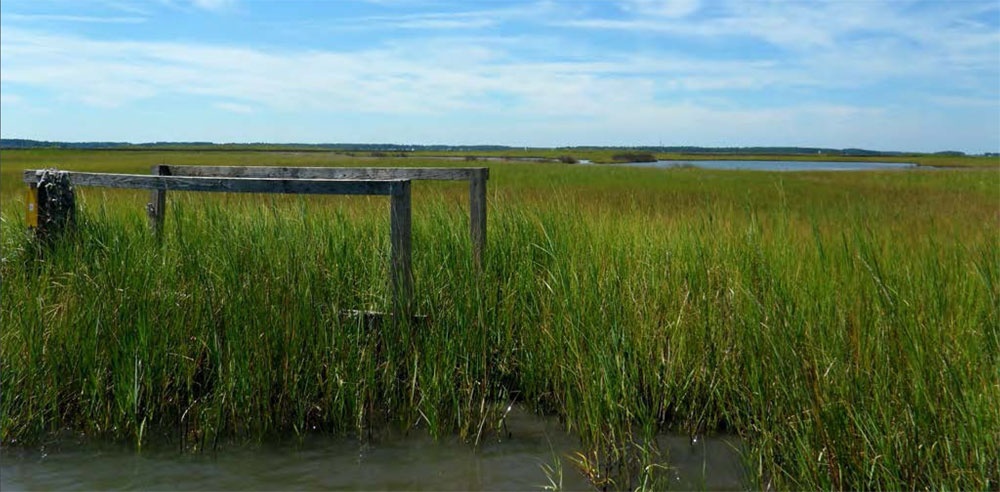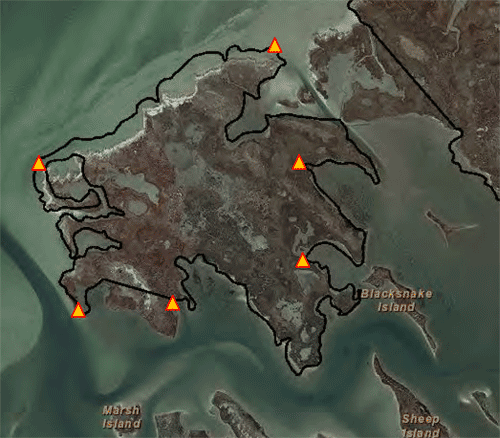 Plum Tree Island Refugee - photo courtesy of Plum Tree Island NWR: Public Scoping (2012-09)
Plum Tree Island Refugee - photo courtesy of Plum Tree Island NWR: Public Scoping (2012-09)
Plum Tree Island National Wildlife Refuge is a National Park Service, part of the Captain John Smith Chesapeake National Historic Trail, as well as part of the Chesapeake Bay Watertrails and Gateways Network and is the largest continuous salt marsh ecosystem in the lower Chesapeake Bay, with an area of 3,501-acre (14.17 km2). Plum Tree Island is located almost in the middle of the Atlantic Flyway, on the southwestern corner of Poquoson, along the Chesapeake Bay. The refuge offers diverse salt marshes, tidal streams and long, wooded ridges that support millions of waterfowl, marsh and wading birds, and shorebirds throughout the year.
Only Cow Island 200-acre (0.81 km2) is open to the public, as it was once used by the Air Force for ordnance testing. It still offers pristine beaches that are secluded and ideal for habitats and breeding, offering the rare opportunity for the visitor to enjoy an expansive view of the Chesapeake Bay ecosystem.
 Plum Tree Island Refugee is known for Bird Observing- photo courtesy of Plum Tree Island NWR: Public Scoping (2012-09)
Plum Tree Island Refugee is known for Bird Observing- photo courtesy of Plum Tree Island NWR: Public Scoping (2012-09)
Noteworthy Bird Observations
The following birds have been observed at Plum Tree Island: Common Loon, Brown Pelican, Double-crested Cormorant, Tundra Swan, Canada Goose, Snow Goose, Mallard, Black Duck, Blue-winged Teal, Green-winged Teal, Canvasback, Greater Scaup, Lesser Scaup, Common Goldeneye, Bufflehead, Red-breasted Merganser, Vulture, Red-shouldered Hawk, Northern Harrier, Osprey, Bobwhite, Yellow-crowned Night Heron, Green-backed Heron, Tricolored Heron, Little Blue Heron, Snowy Egret, Great Egret, Great Blue Heron, American Bittern, Glossy Ibis, Clapper Rail, Virginia Rail, American Oystercatcher, Whimbrel, Black-necked Stilt, Willet, Greater Yellowlegs, Lesser Yellowlegs, Short-billed Dowitcher, Dunlin, Semi-palmated Sandpiper, Great Black-backed Gull, Laughing Gull, Herring Gull, Common Tern, Forster’s Tern, Least Tern, Sandwich Tern, Black Skimmer, Mourning Dove, Kingfisher, Chimney Swift, Eastern Kingbird, Tree Swallow, Purple Martin, Rough-winged Swallow, Barn Swallow, American Crow, Fish Crow, House Wren, Marsh Wren, Sedge Wren, Catbird, Starling, Prairie Warbler, Yellow Warbler, Common Yellowthroat, Indigo Bunting, Sharp-tailed Sparrow, Seaside Sparrow, Song Sparrow, Eastern Meadowlark, Red-winged Blackbird, Brown-headed Cowbird, Boat-tailed Grackle, American Goldfinch
Waterfowl hunting is permitted on Cow Island only; it has no other public uses.
 USFWS Hunting Blinds on Cows Island - photo courtesy of Plum Tree Island NWR: Public Scoping (2012-09)
USFWS Hunting Blinds on Cows Island - photo courtesy of Plum Tree Island NWR: Public Scoping (2012-09)


